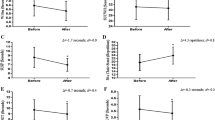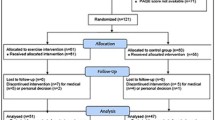Abstract
This study analyzed the evolution in peak torque (PT) and mean power (MP) isokinetic parameters in the quadriceps and hamstring muscles of elderly sedentary women who were randomly selected to participate in a brisk walking program for 6 months. The 121 sedentary women of this study presented a mean score of 5.3 (±1.7) on the Physical Activity Questionnaire for the Elderly and covered 86 % of the theoretical distance on the 6-min walk test. The isokinetic evaluation was performed on both sides at 60°/s and 180°/s. PT and MP were selected for analysis. Women in the trained group (n = 61) participated in a program of 78 sessions over 6 months with three sets of 60 min of exercise per week. For this group, heart rate, time and distance were, respectively, 125.2 bt/min (±10), 37.9 min (±4.2) and 3756.3 m (±445.4). The analysis of the group × time interaction demonstrated an increase in the PT of the dominant-side hamstrings (p < 0.001). In the trained group, we observed a significant increase in PT at 60°/s for the hamstrings on both sides (0.01 < p < 0.02) and a significant increase in MP for the hamstrings at 60°/s on the nondominant side (p < 0.05). The study indicates a minor, though significant, influence of a brisk walking program on the peak torque and mean power of the quadriceps and hamstring muscles in sedentary women over 60 years.
Similar content being viewed by others
References
Shephard RJ (2009) Independence: a new reason for recommending regular exercise to your patients. Phys Sportsmed 37:115–118
Vandervoort AA (2002) Aging of the human neuromuscular system. Muscle Nerve 25:17–25
Samuel D, Wilson K, Martin HJ et al (2012) Age-associated changes in hand grip and quadriceps muscle strength ratios in healthy adults. Aging Clin Exp Res 24:245–250
Liu CJ, Latham NK (2009) Progressive resistance strength training for improving physical function in older adults. Cochrane Database Syst Rev 10:1858
Peterson MD, Gordon PM (2011) Resistance exercise for the aging adult: clinical implications and prescription guidelines. Am J Med 124:194–198
Jegu AG, Pereira B, Andant N et al (2014) Effect of eccentric isokinetic strengthening in the rehabilitation of patients with knee osteoarthritis: Isogo, a randomized trial. Trials 15:106
Seynnes O, Fiatarone Singh MA, Hue O et al (2004) Physiological and functional responses to low-moderate vs. high intensity progressive resistance training in frail elders. J Gerontol 59A:503–509
Watanabe Y, Madarame H, Ogasawara R et al (2014) Effect of very low-intensity resistance training with slow movement on muscle size and strength in healthy older adults. Clin Physiol Funct Imaging 34:463–470
Cadore EL, Izquierdo M (2013) New strategies for the concurrent strength-, power-, and endurance-training prescription in elderly individuals. J Am Med Dir Assoc 14:623–624
Cadore EL, Pinto RS, Bottaro M et al (2014) Strength and endurance training prescription in healthy and frail elderly. Aging Dis 5:183–195
Fyfe JJ, Bishop DJ, Stepto NK (2014) Interference between concurrent resistance and endurance exercise: molecular bases and the role of individual training variables. Sports Med 44:743–762
Tsang WW, Hui-Chan CW (2005) Comparison of muscle torque, balance, and confidence in older tai chi and healthy adults. Med Sci Sports Exerc 37:280–289
Wu G, Zhao F, Zhou X et al (2002) Improvement of isokinetic knee extensor strength and reduction of postural sway in the elderly from long-term Tai Chi exercise. Arch Phys Med Rehabil 83:1364–1369
Perchthaler D, Grau S, Hein T (2015) Evaluation of a 6-week whole-body vibration intervention on neuromuscular performance in older adults. J Strength Cond Res 29:86–95
Roelants M, Delecluse C, Verschueren SM (2004) Whole-body-vibration training increases knee-extension strength and speed of movement in older women. J Am Geriatr Soc 52:901–908
Fatouros IG, Taxildaris K, Tokmakidis SP et al (2002) The effects of strength training, cardiovascular training and their combination on flexibility of inactive older adults. Int J Sports Med 23:112–119
Lee JS, Kim CG, Seo TB et al (2015) Effects of 8-week combined training on body composition, isokinetic strength, and cardiovascular disease risk factors in older women. Aging Clin Exp Res 27:179–186
Mandic S, Tymchak W, Kim D et al (2009) Effects of aerobic or aerobic and resistance training on cardiorespiratory and skeletal muscle function in heart failure: a randomized controlled pilot trial. Clin Rehabil 23:207–216
Marzolini S, Oh PI, Brooks D (2012) Effect of combined aerobic and resistance training versus aerobic training alone in individuals with coronary artery disease: a meta-analysis. Eur J Prev Cardiol 19:81–94
Cadore EL, Moneo AB, Mensat MM et al (2014) Positive effects of resistance training in frail elderly patients with dementia after long-term physical restraint. Age 36:801–811
Carvalho J, Marques E, Soares JM et al (2010) Isokinetic strength benefits after 24 weeks of multicomponent exercise training and combined exercise training in older adults. Aging Clin Exp Res 22:63–69
Zhuang J, Huang L, Wu Y et al (2014) The effectiveness of a combined exercise intervention on physical fitness factors related to falls in community-dwelling older adults. Clin Interv Aging 9:131–140
Chomiuk T, Folga A, Mamcarz A (2013) The influence of systematic pulse-limited physical exercise on the parameters of the cardiovascular system in patients over 65 years of age. Arch Med Sci 9:201–209
Figard-Fabre H, Fabre N, Leonardi A et al (2011) Efficacy of Nordic walking in obesity management. Int J Sports Med 32:407–414
Tschentscher M, Niederseer D, Niebauer J (2013) Health benefits of nordic walking: a systematic review. Am J Prev Med 44:76–84
Gordon CD, Wilks R, McCaw-Binns A (2013) Effect of aerobic exercise (walking) training on functional status and health-related quality of life in chronic stroke survivors: a randomized controlled trial. Stroke 44:1179–1181
Ohkawara K, Tanaka S, Miyachi M et al (2007) A dose-response relation between aerobic exercise and visceral fat reduction: systematic review of clinical trials. Int J Obes 31:1786–1797
Abe T, Sakamaki M, Fujita S et al (2010) Effects of low-intensity walk training with restricted leg blood flow on muscle strength and aerobic capacity in older adults. J Geriatr Phys Ther 33:34–40
Ozaki H, Loenneke JP, Thiebaud RS et al (2013) Possibility of leg muscle hypertrophy by ambulation in older adults: a brief review. Clin Interv Aging 8:369–375
Ozaki H, Sakamaki M, Yasuda T et al (2011) Increases in thigh muscle volume and strength by walk training with leg blood flow reduction in older participants. J Gerontol A Biol Sci Med Sci 66:257–263
Voorrips LE, Ravelli AC, Dongelmans PC et al (1991) A physical activity questionnaire for the elderly. Med Sci Sports Exerc 23:974–979
Troosters T, Vilaro J, Rabinovitch R et al (2002) Physiological responses to the 6-minute walk test in patients with chronic obstructive pulmonary disease. Eur Respir J 20:564–569
Statement ATS (2002) Guidelines for the 6-minute walk test. Am J Respir Crit Care Med 166:111–117
Beauchamp MK, Nonoyama M, Goldstein RS et al (2010) Interval versus continuous training in individuals with chronic obstructive pulmonary disease: a systematic review. Thorax 65:157–164
Ramos JS, Dalleck LC, Tjonna AE et al (2015) The impact of high-intensity interval training versus moderate-intensity continuous training on vascular function: a systematic review and meta-analysis. Sports Med 45:679–692
Acknowledgments
The authors would like to thank A. Bussonne and the FFEPGV for collaboration on this research. The authors are very grateful to Lauren Oswald for presubmission editorial assistance.
Author information
Authors and Affiliations
Corresponding author
Ethics declarations
Conflict of interest
None.
Human and animal rights
All procedures performed in studies involving human participants were in accordance with the ethical standards of the institutional and/or national research comittee and with the 1964 Helsinki declaration and its later amendments or comparable ethical standards. This article does not contain any studies with animals performed by any of the authors.
Informed consent
Informed consent was obtained from all individual participants included in the study.
Rights and permissions
About this article
Cite this article
Bernard, P.L., Tallon, G., Ninot, G. et al. Influence of a brisk walking program on isokinetic muscular capacities of knee in sedentary older women. Aging Clin Exp Res 28, 1219–1226 (2016). https://doi.org/10.1007/s40520-015-0523-0
Received:
Accepted:
Published:
Issue Date:
DOI: https://doi.org/10.1007/s40520-015-0523-0




